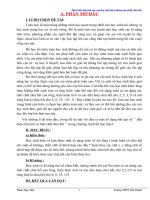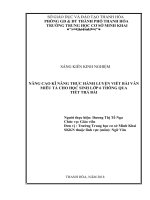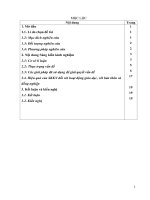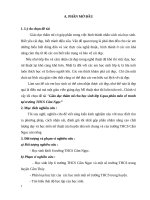skkn cấp tỉnh nâng cao hiệu quả học ngữ pháp cho học sinh lớp 6 thông qua sử dụng sơ đồ tư duy
Bạn đang xem bản rút gọn của tài liệu. Xem và tải ngay bản đầy đủ của tài liệu tại đây (801.21 KB, 23 trang )
<span class="text_page_counter">Trang 1</span><div class="page_container" data-page="1">
SỞ GIÁO DỤC VÀ ĐÀO TẠO THANH HÓA PHÒNG GD & ĐT THỌ XUÂN
SÁNG KIẾN KINH NGHIỆM
<b> SOME EXPERIENCES IN IMPROVING LEARNING </b>
<b>GRAMMAR EFFECTIVELY BY USING MIND MAPS </b>
<b> FOR STUDENTS OF GRADE 6 </b>
Người thực hiện : Nguyễn Thị Thúy Chức vụ : Giáo viên
Đơn vị công tác : Trường THCS Nam Giang SKKN thuộc lĩnh vực : Tiếng Anh
THANH HÓA
</div><span class="text_page_counter">Trang 2</span><div class="page_container" data-page="2"><b> 1. INTRODUCTION1.1. Reasons for choosing the research </b>
English is an international language which has developed quickly. It is a subjectthat features regularly on study timetables all over the world. Every country does notwant to be isolated in international communication, so it puts English in curriculum oftheir education at programme. In Vietnam, English is a compulsory subject at schoolsand it has recently been chosen as a compulsory subject in the national examinationfor the General Certificate of Secondary Education or GCSE for short. Besides thefour skills, having a good knowledge of grammar is an important element in secondlanguage acquisition. By learning new grammar, learners can enhance their listening,speaking, reading and writing as well as improve comprehension and production insecond language. Grammar learning strategies are one part of language learningstrategies which in turn are part of general learning strategies. One of the strategies toteach grammar is to apply images and review well in a structured way. Besides , it’stoo boring for students at secondary school to learn grammer , especially students ingrade 6 .They aren’t used to learn grammar at secondary school . Because they oftenlearnt a structure or one moden sentences ,It was easy for them to reach .Manystudents feel bored with grammar lesson. Moreovers, using mind maps is consideredto be one of the techniques or activities which can be used in eliciting students how tostudy and use vocabulary more effectively.
For all the reasons mentioned above, I have decided to choose” Some
<b>experiences in improving learning grammar effectively by using mind maps for students of grade 6 " as the topic of my experience initiative.</b>
<b>1.2. Aim</b>
The study is aimed at finding the ways in helping students to study and use grammarby using mind maps for students of grade 6 at ....secondary school effectively with theilearn smart 6
<b>1.5. New points of my experience initiative:</b>
The research will be useful to students, teachers and researchers in the field of Englishlanguage teaching and learning: students can use mind mapping (MM) model to studyand use grammar more quickly and more effectively; teachers can understand more
</div><span class="text_page_counter">Trang 3</span><div class="page_container" data-page="3">about the MM model and use it to teach grammar more effectively in their lessons;and researchers will use the study as a reliable source of reference in their research.
<b> 2. CONTENT</b>
<b>2.1. Theoretical background:</b>
<b>2.1.1. An overview of grammar </b>
<b> Grammar is concerned with making completely explicit the formalism of </b>
grammar and in providing scientist arguments or explanations in favour of one account of grammar rather than another ,in terms of a general theory of human language ( Antoine Renouf and Andrew Kehoe , The Changing Face of Corpus Linguistics .Rodopi,2003)
<i><b>2.1.1.1.Traditional Grammar</b></i>
<i><b> What generative linguists meansby grammar shouldn’t not be confused, in the</b></i>
frist íntance , with what ordinary persons or nonlinguistist might refer to that term .Apedagogical grammar typically provide paradigms of these
construction list of prominent exception to these constructions ( irregularverbs,etc....) and descriptive commentary at various level of detail and generalityabout form and meaning of expression
<i><b>2.1.1.2. Descriptive Grammar </b></i>
<b> A descriptive grammar catalogues the facts of a language ,whereas a</b>
theoretical grammar uses some theoryabout nature of language to explain why thelanguage contain forms and not other ( Paul Baker Andrew Hardie ,and Tony McEnery ,A Glossary of Corpus Lingistics , Edinburgh Univ .Press 2006 )
<b>2.1.1.3. Strategies of eliciting students how to study and use grammar</b>
* Stages and techniques in eliciting students how to study and use Grammar
<i><b>a. Presenting</b></i>
At this stage, the teacher presents the new words and the techniques are often used such as translation, real things, pictures, actions /gestures, definitions, situations/ examples.
At this stage, the students are made to practice the model sentences or structure... The techniques are often used such as identifying, selecting, matching, sorting, ranking and sequencing.
<i><b>c.Consolidating and revising</b></i>
At this stage, the techniques are often used such as ordering, , networks, bingo,
wordstorm, matching, noughts and crosses, what and where, jumbed words, guess the pictures / make sentences , give correct forms of verbs
<i><b>2.1.1.4. Grammar in ilearn smart start 6</b></i>
The grammar in English 6 is continued to present and build up according totenses , strusctures . That is why using mind maps is believed to be a good way tohelp students not only review the learned structures in grammar but also learn the
</div><span class="text_page_counter">Trang 4</span><div class="page_container" data-page="4"><b>2.1.2. An overview of mind maps.</b>
<i><b>2.1.2.1. Definition </b></i>
Buzan states that a mind map is a powerful graphic technique which provides auniversal key to unlock the potential of the brain. It is a visual map of ideas, laid outin a radial format around a central thought and it involves a unique combination ofimagery, colour and visual-spatial arrangement which is proven to significantlyimprove recall when compared to conventional methods of note-taking and learningby rote. It needs imagination and association to activate our brain in rememberingsomething.
Based on DePotter and Hernacki as translated into English (in Abdurrahman,2008:153), “Mind mapping is the use of whole brains technique by using thevisualization and other graphic infrastructure to make an impression”. Besides, mindmapping is one of techniques which can make the students more enjoyable andinteresting in studying vocabulary.
According to Martin as translated into English (in Trianto, 2009:158) mindmapping is a concrete graphic illustration which indicates how a single conceptrelated to other concept in the same categories. Mind mapping is a pattern which atleast consists of picture, symbol and colour that will not just help the students tounderstand the vocabulary knowledge but also make the students feel good, enjoyableand attract their brain which at last leads them to have interest in mastery vocabularyknowledge.
<i><b>2.1.2.2. Classifications</b></i>
Trianto (2009:160) describes that mind mapping can be distinguished into fourkinds, namely; (1) network tree, (2) event chain, (3) cycle concept map, and (4) spiderconcept map.
2.1.2.2.1. Event Chain
The event chain can be used for giving an accident order, steps in a procedure,or steps in a process. It is suitable for visualization (a) some steps in a process, (b)some steps in a linier procedure, and (c) an accident order.
</div><span class="text_page_counter">Trang 5</span><div class="page_container" data-page="5">branch procedure, and (d) technical terms which can be used to explain somecorrelations.
<b>2.1.2.2.3. Cycle Concept Map</b>
In this concept map, the accident combination has no final result. It is suitableto show a correlation how a combination accident is interacting to produce a group ofresult repeatedly.
2.1.2.2.4.Spider Concept Map
The spider concept can be used for sharing opinion from a central idea until getmore various big ideas. It is suitable to visualize (a) something which is not based onhierarchy (b) a category which is not parallel, and (d) the result of sharing opinion. Example: Unit 7 : movies
</div><span class="text_page_counter">Trang 6</span><div class="page_container" data-page="6">Mind mapping is similar to a road makes study, work and thinking enjoyable, itcan help to solve the lack of stock of students’ grammar in memorizing somestructures which are related from universal structures as a key word.
<b>2.1.3. How to make a mind map.</b>
<i><b>2.1.3.1. Parts of Mind Mapping Technique</b></i>
There are some parts of mind mapping (Windura, 2008:77-86) namely; (1)central image, (2) key word, (3) basic ordering ideas, (4) branches, (4) colour and (5)picture.
2.1.3.1.1. Central Image
A central image has to describe the main idea of a mind mapping and put it onthe centre of the paper. It activates the students’ right brain, strengthen the students’memory and makes the learning activity enjoyable.
2.1.3.1.2. Key Word
A key word is a word that can lead a sentence or an event. Identifying afamiliar word in one’s own language or another language that sounds like the newword and using only one key word per line. It is as an urge to remember a lot ofwords for the students. It is a strong noun or verb that creates an image to recall thememory.
2.1.3.1.3. Basic Ordering Ideas
</div><span class="text_page_counter">Trang 7</span><div class="page_container" data-page="7">Basic ordering ideas are the branches that collect sort information and it isconnected to the central topic that radiate out from the centre. Making basic orderingideas which can direct our mind to make a mind map and it needs the creativity thatencourages the students to understand to the material. It is thick and thinner at theends. It can be seen as headings for your topic and spread anywhere but do notbecome steep.
2.1.3.1.4. Branches
The branches should be curvy and in the same length as the words or picturesabove it. These branches can be seen as sub headings. It is thinner branches andcontaining details.
2.1.3.1.5. Colour
Colour is a very good memory sign and it involves the right brain in learningfor long term memory. Colours encourage creativity and help in memorization.Adding plenty of colours via branches, map background and images will add life toyour mind map. It makes easier to comprehend and remember.
2.1.3.1.6. Pictures
In mind mapping, pictures which can change or strengthen a key word that hasbeen written before.
<i><b>* The Criteria of Making Mind Mapping Technique</b></i>
Based on what Buzan (in Purwoko, 2005:20) states that the mind mapping usescolors and pictures to help constructing your imagination with your style in makingmind maps. Words or pictures which are in the curvy lines or branches will help the
<b>students’ memory to make associations. </b>
Moreover, Buzan (in Purwoko, 2005:20) explains the steps below in how tomake a mind map, they are presented below;
<b>Step 1.</b> Take a piece of white paper and it is in a landscape position.
<b>Step 2. Start by drawing a coloured image in the centre of the paper and write the key</b>
word with capital letters.
<b>Step 3.</b> Choose a color and draw the main themes of the mind map on the thickbranches radiating out from the central image.
<b>Step 4. Add other main themes branches around the map.</b>
<b>Step 5.</b> Make thick and colourful branches spanning out from your mind map.
<b>Step 6.</b> Write basic ideas about the key word and still use the capital letters.
<b>Step 7.</b> Add an image to all the main branches to represent each key theme and alsouse images to visualise every important key word on your map.
<b>Step 8.</b> Let your mind map be as imaginative as possible.
<b>2.1.4. The applications of mind maps in eliciting students how to study and use grammar effectively</b>
<i><b>2.1.4.1. Using mind maps in eliciting students how to study and use grammar </b></i>
One of the simplest ways how to use a mind map is gathering and sorting new
grammar . The example shows the presentcontinuos organized in 4 groups . Students
</div><span class="text_page_counter">Trang 8</span><div class="page_container" data-page="8">find it much easier to memorize the knowledge which they are placed in a certain spot, connected to a certain stucture .
<b>Example: Unit 3 : Friends</b>
<i><b>2.1.4.2. Using mind maps to elicit students how to take notes and plan tasks.</b></i>
Another way of using a mind map is giving students a task where they have todisplay a summary of some structures , for example,the past simple tense . Eachbubble may contain more than one word or even a phrase. This mind map can be usedby the students in the classroom for making a short speech or a comment about thepast simple tense such as uses , form ... If a mind map is created by the teacherand shown at the lesson, it can be used as a basic for classroom discussion or awriting task.
Older students may use a mind map for outlining their report or an essay.
<b>Example: Unit 10 :</b>
</div><span class="text_page_counter">Trang 9</span><div class="page_container" data-page="9"><b>2.2. Problematic situation of studying and using English granmar at my school.2.2.1. Advantages</b>
My school is one of the best schools in Tho Xuan district with a lot of outstandingachievements. Teaching and learning English are more and more attached here.
<i><b>2.2.1.1. About the teachers of English.</b></i>
At my school, there are three English teachers aged from 40 to 45. English for over 10years. We are all young, enthusiastic, active, creative and willing to devote toteaching career. Both of us can apply new teaching method, the informationtechnology, teaching aids to teaching skillfully. We are also familiar with thetechniques of teaching and eliciting vocabulary.
<i><b>2.2.1.2. About the students.</b></i>
All of the students have learnt English for 3 years at primary schools. Most of themare obedient and dutiful. They also know how important the English is and they arealso familiar with the different ways of studying and using vocabulary.
<b>2.2.2. Disadvantages.</b>
Besides the advantages above, eliciting for students how to study and use Englishgrammae also have some difficulties and feel boring in grammar lesson.
<i><b>2.2.2.1. About the teachers.</b></i>
Some teachers still face a number of difficulties in the implementation of certainoperations, teaching techniques of each lesson, each stage of the lesson or thecombination of the teaching techniques.
Some teachers are still afraid of using or even do not use teaching aids proficiently forthe lesson (For example: laptop, projector, cassette, CD,...).
In eliciting grammar, some teachers do not use the different techniques. They oftenlist the new structures on the board then explain them and do not practise the model
</div><span class="text_page_counter">Trang 10</span><div class="page_container" data-page="10">a lot , which is not easy for students to learn the grammar eagerly, quickly, andpermanently.
<i><b>2.2.2.2. About the students.</b></i>
Although all of the students have learnt English for 3 years at primary schools, theyare different from levels. A number of them are interested in learning speech ,listening ....beacuse they feel fun . Besides , many students are bored with theirgrammar lessons .Therefore , they are afraid of taking pảt in grammar lesson.
. That is why they do not have enough knowledge of grammar to express their ideasin writing and speaking and they do not understand what they hear or they do in a test.Consequently, the way to present the grammar is very important to make sure thatthey can remember the form of the structures and how to use them correctly inEnglish
2.2.2.3. Specific survey.
In the process of teaching, I have been given the duty to teach grade 6. With the awareness of researching and studying the situation of students’ learning thesubject and learning from experience, right since the beginning of the school year, Ioutlined a specific plan and method to actively investigate the situation of students’learning in my classes. Though the investigation in four skills, I realized that moststudents are neither recognized nor sure about the grammar they had listened inwriting skill. Hardly did they use the right structures to express their ideas in speakingand writing skills. In reading skill, they had difficult understanding the text because ofa number of new structures. Before applying the experience initiative in elicitingstudents of grade 6 to study and use grammar for Unit 1: home , I asked SS to writehome of Unit 1 and make up sentences with them in 10 minutes . The survey result asfollows:
<b>hobbies &sentences</b>
<b>hobbies &sentences</b>
<b>7-->8 </b>
<b>hobbies &sentences</b>
<b>hobbies &sentences</b>
<b>hobbies &sentences</b>
<b> Teachers can use the technique to teach verbs, the different forms of verbs, the </b>
different parts of speech of words, the different meanings of words, words related to asubject, collocation words (words that are commonly used together) and so on. By using the technique, students will revise the words they have learnt and learn the new ones from their teacher as well as their friends. They will also have their own maps ofdifferent tasks at home.
</div><span class="text_page_counter">Trang 11</span><div class="page_container" data-page="11"><b>Example: Unit 1 : Home</b>
<b>2.2.3.1.The steps of eliciting:</b>
<i><b>Step 1:</b></i><b> Make a central image/topic in the centre of the paper. Colour and add</b>
something interesting.
<i><b>Step 2:</b></i><b> Draw some basic ordering ideas, spread out from the central image/topic.</b>
<i><b>Step 3:</b></i><b> Thinking of all something interesting as much as possible and funny for you</b>
and it can be connected with the central image to give you the inspiration.
<i><b>Step 4:</b></i><b> Add some branches to the basic ordering ideas using symbols, pictures, and</b>
colours as much as possible.
<i><b>Step 5:</b></i><b> Thinking of the details which are interesting and it can encourage your</b>
curiousity. Add to your mind map.
<i><b>Step 6 :</b></i><b> Continue it until you have adequate information for your mind map.</b>
<b>2.2.3.2. Example Unit 6 : Community services </b>
</div>








